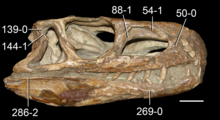
Back Euparkeriidae Spanish هوپارکریان Persian Euparkeriidae French אאופרקריים HE Euparkeriidae Hungarian Euparkeriidae Dutch Euparkeriidae Polish 派克鱷科 Chinese
| Euparkeriids Temporal range: Middle Triassic - Late Triassic,
| |
|---|---|

| |
| The skull of Euparkeria capensis | |
| Scientific classification | |
| Domain: | Eukaryota |
| Kingdom: | Animalia |
| Phylum: | Chordata |
| Class: | Reptilia |
| Clade: | Archosauromorpha |
| Clade: | Archosauriformes |
| Clade: | Eucrocopoda |
| Family: | †Euparkeriidae Huene, 1920 |
| Genera | |
Euparkeriidae is an extinct family of small carnivorous archosauriforms which lived from the Early Triassic to the Middle Triassic (Anisian). While most other early archosauriforms walked on four limbs, euparkeriids were probably facultative bipeds that had the ability to walk on their hind limbs at times. The most well known member of Euparkeriidae is the species Euparkeria capensis, which was named by paleontologist Robert Broom from the Karoo Basin of South Africa in 1913 and is known from several nearly complete skeletons. The family name was first proposed by German paleontologist Friedrich von Huene in 1920; Huene classified euparkeriids as members of Pseudosuchia, a traditional name for crocodilian-line archosaurs from the Triassic (Pseudosuchia means "false crocodiles"). However, phylogenetic analyses performed in the 21st century place Euparkeriidae as a group of Archosauriformes, a position outside Pseudosuchia and close to the ancestry of both crocodile-line archosaurs and bird-line archosaurs (which include dinosaurs and pterosaurs). However, they are probably not direct ancestors of archosaurs.
Several other species apart from Euparkeria have been assigned to the family, but many are dubious or have been determined to have been placed in the family incorrectly. One study has suggested that Euparkeriidae may not represent a true evolutionary grouping or clade. Instead, the family may represent an evolutionary grade of small archosauriforms (making it paraphyletic) or a group of species that each evolved small body sizes through evolutionary convergence (making it polyphyletic).[1] However, other studies consider the family valid, albeit difficult to diagnose.[2][3] Euparkeriidae is defined as the most inclusive clade containing Euparkeria capensis but not Crocodylus niloticus (the nile crocodile) or Passer domesticus (the house sparrow).
- ^ Sookias, R. B.; Butler, R. J. (2013). "Euparkeriidae". Geological Society, London, Special Publications. 379: 35–48. doi:10.1144/SP379.6.
- ^ Cite error: The named reference
SB14was invoked but never defined (see the help page). - ^ Cite error: The named reference
:0was invoked but never defined (see the help page).
© MMXXIII Rich X Search. We shall prevail. All rights reserved. Rich X Search